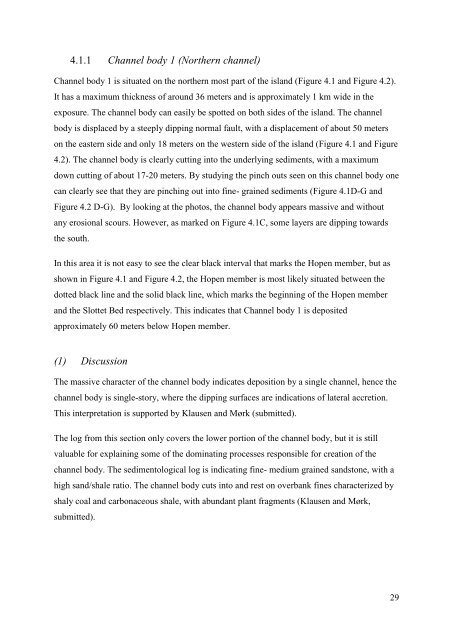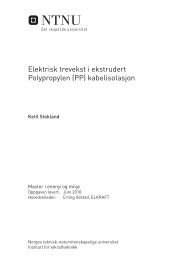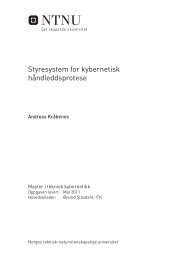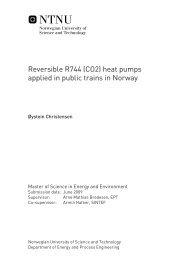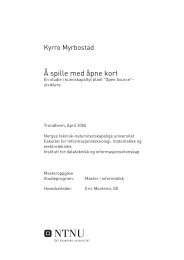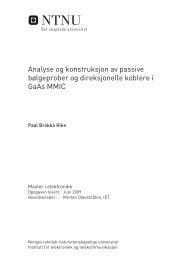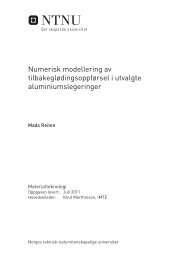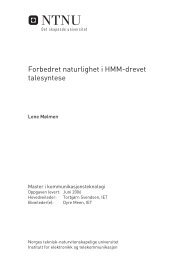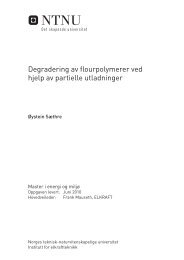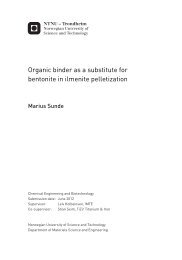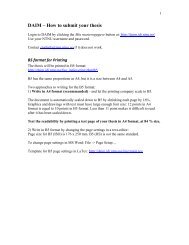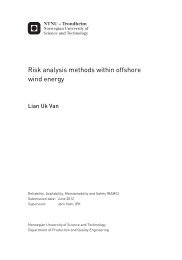Visualize and interpret the geometry, heterogeneity and lateral ...
Visualize and interpret the geometry, heterogeneity and lateral ...
Visualize and interpret the geometry, heterogeneity and lateral ...
You also want an ePaper? Increase the reach of your titles
YUMPU automatically turns print PDFs into web optimized ePapers that Google loves.
4.1.1 Channel body 1 (Nor<strong>the</strong>rn channel)Channel body 1 is situated on <strong>the</strong> nor<strong>the</strong>rn most part of <strong>the</strong> isl<strong>and</strong> (Figure 4.1 <strong>and</strong> Figure 4.2).It has a maximum thickness of around 36 meters <strong>and</strong> is approximately 1 km wide in <strong>the</strong>exposure. The channel body can easily be spotted on both sides of <strong>the</strong> isl<strong>and</strong>. The channelbody is displaced by a steeply dipping normal fault, with a displacement of about 50 meterson <strong>the</strong> eastern side <strong>and</strong> only 18 meters on <strong>the</strong> western side of <strong>the</strong> isl<strong>and</strong> (Figure 4.1 <strong>and</strong> Figure4.2). The channel body is clearly cutting into <strong>the</strong> underlying sediments, with a maximumdown cutting of about 17-20 meters. By studying <strong>the</strong> pinch outs seen on this channel body onecan clearly see that <strong>the</strong>y are pinching out into fine- grained sediments (Figure 4.1D-G <strong>and</strong>Figure 4.2 D-G). By looking at <strong>the</strong> photos, <strong>the</strong> channel body appears massive <strong>and</strong> withoutany erosional scours. However, as marked on Figure 4.1C, some layers are dipping towards<strong>the</strong> south.In this area it is not easy to see <strong>the</strong> clear black interval that marks <strong>the</strong> Hopen member, but asshown in Figure 4.1 <strong>and</strong> Figure 4.2, <strong>the</strong> Hopen member is most likely situated between <strong>the</strong>dotted black line <strong>and</strong> <strong>the</strong> solid black line, which marks <strong>the</strong> beginning of <strong>the</strong> Hopen member<strong>and</strong> <strong>the</strong> Slottet Bed respectively. This indicates that Channel body 1 is depositedapproximately 60 meters below Hopen member.(1) DiscussionThe massive character of <strong>the</strong> channel body indicates deposition by a single channel, hence <strong>the</strong>channel body is single-story, where <strong>the</strong> dipping surfaces are indications of <strong>lateral</strong> accretion.This <strong>interpret</strong>ation is supported by Klausen <strong>and</strong> Mørk (submitted).The log from this section only covers <strong>the</strong> lower portion of <strong>the</strong> channel body, but it is stillvaluable for explaining some of <strong>the</strong> dominating processes responsible for creation of <strong>the</strong>channel body. The sedimentological log is indicating fine- medium grained s<strong>and</strong>stone, with ahigh s<strong>and</strong>/shale ratio. The channel body cuts into <strong>and</strong> rest on overbank fines characterized byshaly coal <strong>and</strong> carbonaceous shale, with abundant plant fragments (Klausen <strong>and</strong> Mørk,submitted).29


